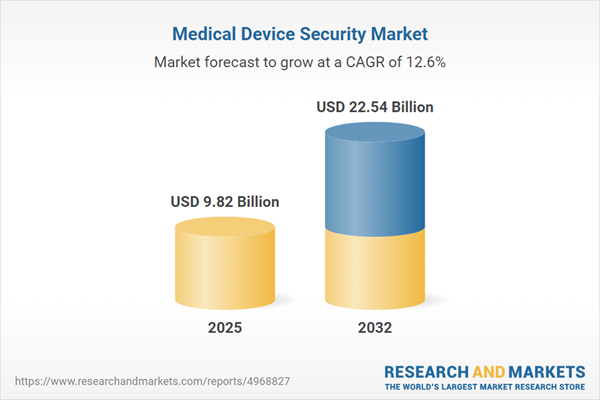Speak directly to the analyst to clarify any post sales queries you may have.
Healthcare leaders face increasing pressure to safeguard both clinical and operational environments from evolving security threats as digital transformation reshapes care delivery. The medical device security market provides critical solutions to protect organizational resilience, maintain compliance, and ensure patient trust across diverse healthcare settings.
Market Snapshot: Medical Device Security Market Overview
In 2024, the global medical device security market is valued at USD 8.74 billion and is growing at a compound annual growth rate (CAGR) of 12.56%. This robust trajectory reflects intensified digitization across the healthcare sector, notably with the introduction of 5G networks and real-time analytics. Medical device security has become strategically vital as health systems increasingly operate in cloud and hybrid models, focusing on consistent operational reliability while addressing modern cybersecurity threats and regulatory pressures. Solutions providers are evolving their offerings with adaptive approaches to match the pace of technological innovation and emerging risks within the sector.
Scope & Segmentation in the Medical Device Security Market
- Device Types: Security challenges differ by device, including anesthesia workstations, infusion pumps, patient monitoring equipment, and imaging machines. Each category requires tailored monitoring and integration to account for unique clinical workflows and risks.
- Component Categories: Effective protection combines hardware gateways, advanced software controls, cloud security protocols, and consulting services. These elements work together to coordinate incident response and simplify compliance across institutional environments.
- End Users: Hospitals, outpatient centers, clinics, diagnostic labs, and home care providers rely on security architectures that reflect their operational complexity and specific exposures. Each user group brings distinct requirements for policy design and technology selection.
- Deployment Models: Implementations leverage cloud, on-premises, and hybrid solutions to suit organizational capabilities and ensure alignment with compliance and governance priorities.
- Connectivity Modalities: Protection strategies focus on both wired and wireless connections to ensure data confidentiality and integrity throughout multiple facilities or remote care sites through encryption and secure protocols.
- Regional Markets: The Americas, Europe, Middle East, Africa, and Asia-Pacific each present unique constraints, regulations, and market drivers. Regional differences in regulatory frameworks and cyber readiness shape technology adoption and investment decisions.
- Leading Companies: Vendors including Palo Alto Networks, Cisco Systems, Forescout Technologies, Fortinet, Check Point Software Technologies, Armis, Claroty, CyberMDX, Trend Micro, and Tenable Holdings influence the industry with advanced offerings and flexible service models.
Key Takeaways for Senior Decision-Makers
- Artificial intelligence is enabling healthcare organizations to accelerate threat detection and incident response, improving both clinical workflow continuity and the security of remote care service delivery.
- Integrating secure-by-design principles and comprehensive lifecycle risk assessments throughout device management makes early identification of vulnerabilities possible, supporting compliance even as standards evolve.
- Enhancing oversight across supplier and third-party relationships promotes greater supply chain resilience, defending against operational disruptions and potential security gaps.
- Site-specific security solutions are critical for maintaining productivity and effective risk oversight, especially across decentralized healthcare networks and facilities offering various care services.
- Continuous participation in cybersecurity intelligence-sharing initiatives and access to specialized expertise empower leaders to anticipate shifts in attacker tactics and refine organization-wide protections.
Tariff Impact: Navigating Regulatory and Supply Chain Shifts
Shifting U.S. tariffs and global trade dynamics continue to influence the procurement landscape for medical device security technologies. Healthcare organizations may experience increased hardware costs and undergo more complex vendor reassessments, potentially delaying acquisitions. Senior leaders are encouraged to support close coordination among procurement, IT security, and compliance teams to keep pace with regulatory demands and maintain patient safety in an evolving international supply context.
Methodology & Data Sources
This report utilizes expertise from cybersecurity professionals, biomedical engineering specialists, and healthcare IT strategists. Market insights rely on a blend of vendor documentation, up-to-date regulatory information, and peer-reviewed technical papers. All findings are corroborated using established risk management frameworks to deliver actionable guidance for organizational leaders.
Why This Report Matters: Medical Device Security Market
- Provides focused recommendations for aligning device security initiatives with organization-wide change and evolving compliance requirements across healthcare settings.
- Delivers practical advice for investment decisions, supporting resilience in clinical operations and network infrastructure through proactive, risk-aware strategies.
- Assists leaders in refining governance, procurement, and response protocols to address current regulatory and security realities within the medical device environment.
Conclusion
This report offers senior healthcare executives practical tools for advancing device security planning, guiding investment priorities, and fostering closer collaboration between operations, IT, and compliance leaders.
Additional Product Information:
- Purchase of this report includes 1 year online access with quarterly updates.
- This report can be updated on request. Please contact our Customer Experience team using the Ask a Question widget on our website.
Table of Contents
3. Executive Summary
4. Market Overview
7. Cumulative Impact of Artificial Intelligence 2025
Companies Mentioned
The companies profiled in this Medical Device Security market report include:- Palo Alto Networks, Inc.
- Cisco Systems, Inc.
- Forescout Technologies, Inc.
- Fortinet, Inc.
- Check Point Software Technologies Ltd.
- Armis, Inc.
- Claroty, Inc.
- CyberMDX, Inc.
- Trend Micro Incorporated
- Tenable Holdings, Inc.
Table Information
| Report Attribute | Details |
|---|---|
| No. of Pages | 188 |
| Published | October 2025 |
| Forecast Period | 2025 - 2032 |
| Estimated Market Value ( USD | $ 9.82 Billion |
| Forecasted Market Value ( USD | $ 22.54 Billion |
| Compound Annual Growth Rate | 12.5% |
| Regions Covered | Global |
| No. of Companies Mentioned | 11 |









